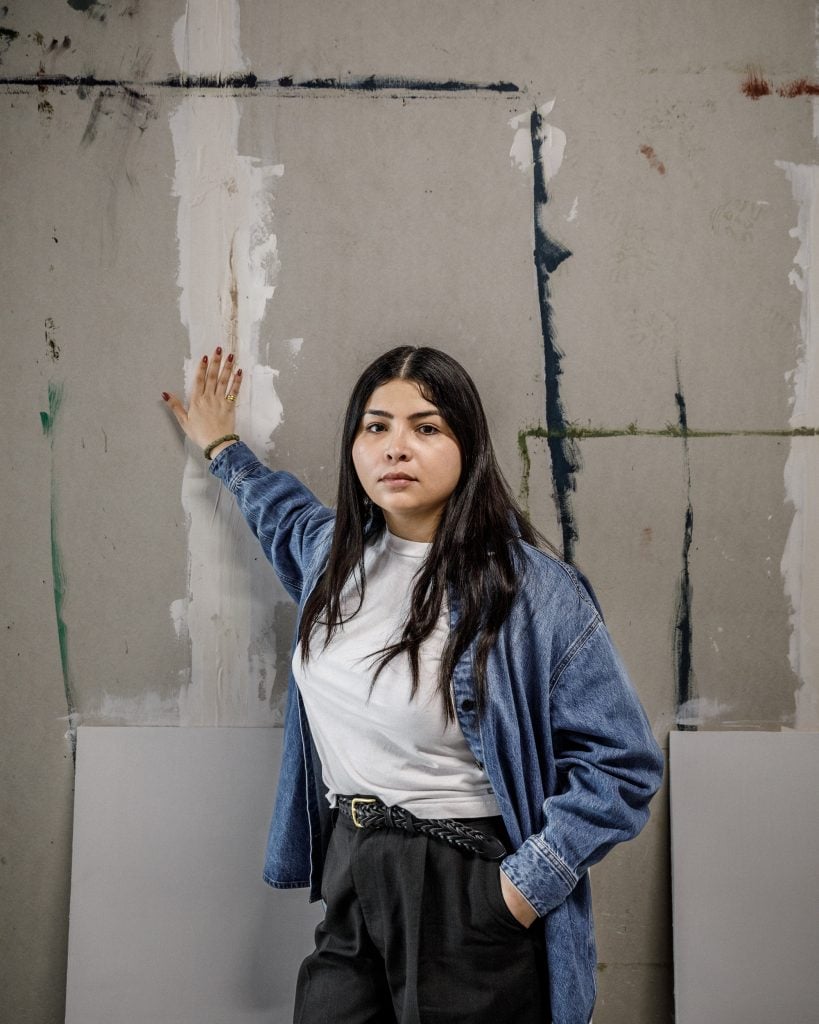Victory Through Air Power III (1943)
2021 - Installation (Installation)
93 x 132 x 4 cm
Wendy Cabrera Rubio
Victory Through Air Power III (1943) by Wendy Cabrera Rubio is part of a series of quilted maps that reproduce different scenes from the eponymous film. Victory Through Air Power the film is an animated history of aviation produced by Walt Disney, and likely one of the first educational and documentary films using animation. Disney’s political agenda, specifically towards Latin America, has played an important role in Cabrera’s practice. This work is not only representative of the artist’s research-based practice. As in many of her hand-crafted pieces combining schematic maps and landscapes with cartoon-like characters, Cabrera also questions traditional didactic displays as well as the exhibition apparatus by turning the art, its didactic labels and random spectator—an exotic bird keeping an eye on his bananas—into the props of a larger staged situation. The series of works Cabrera produced in response to the film also takes inspiration from the six mural paintings that Mexican artist and anthropologist Miguel Covarrubias (1904-1957) painted on the occasion of the 1939 Golden Gate International Exhibition in San Francisco, titled Pageant of the Pacific . Rather than tracing a territory, Covarrubias’s mural paintings celebrated the cultures of the Pacific by putting forward the cultural and economic relations between continents in which the ocean played a major role. Following Covarrubias’s lead, Cabrera transposes his artistic and didactic exercises in anthropological mapping, to the concurrent historical context: the political map of World War II. As suggested by its title and its ideologically charged original referent, Victory Through Air Power III (1943) points to war propaganda against the Japanese as embodied by the supposed accessibility of popular culture and educational films.
Wendy Cabrera Rubio is part of a generation of artists that has been invested in revisiting the history of Mexican arts and crafts with a multidisciplinary and pedagogical approach. Her practice explores the production and distribution of images; using strategies such as appropriation and performance, Cabrera condenses high and low, arts and crafts, history and storytelling. Her work frequently consists of bi-dimensional and three-dimensional quilted objects, cartoon-like characters and/or landscapes made of felt, that stage different narratives (often as a puppet theater) influenced by the educational television programs from the first half of the 20th century. Among the recurrent topics in her work are the concept of the so-called Pan-American history and its relation to North American interventionism in Latin America as embodied by the cultural industries, particularly in Walt Disney’s productions. In this vein, Cabrera’s practice critically addresses the ideological aspects of identity politics.
Colors:
Related works sharing similar palette
» see more

© » KADIST
Leslie Shows
Human Quarry is a large work on paper by Leslie Shows made of a combination of acrylic paint and collage...

© » KADIST
Saturday, March 3 3pm to 4.30pm Exhibition Walkthrough of If These Stones Could Sing and Falling Wall , performance by Public Movement Curator Marie Martraire will lead a walkthrough of If These Stones Could Sing , a group show on view which focuses on the body as a site to engage the politics of public monuments...
Related works found in the same semantic group
» see more

© » KADIST
Colter Jacobsen
2007Victory at Sea is a simple mechanism made from cardboard and found materials that mimics the Phenakistoscope, an early cinematic apparatus...

© » KADIST
Peter Friedl
2005Map 1969-2005, a poster glued on the wall, questions space in its relation to geography...

© » KADIST
Arseny Zhilyaev
His large installation entitled The Museum of Proletarian Culture (2012) looked at the changes in artistic practice that have occurred in Russia throughout the last thirty years – from the amateur art of the late Soviet era to the commercialized post-Soviet cultural practices and the more recent self-expression via contemporary social networks...

© » KADIST
Hamra Abbas
2010At first glance, Cityscapes (2010) seems to be a collection of panoramic photographs of the city of Istanbul—the kind that are found on postcards in souvenir shops...


